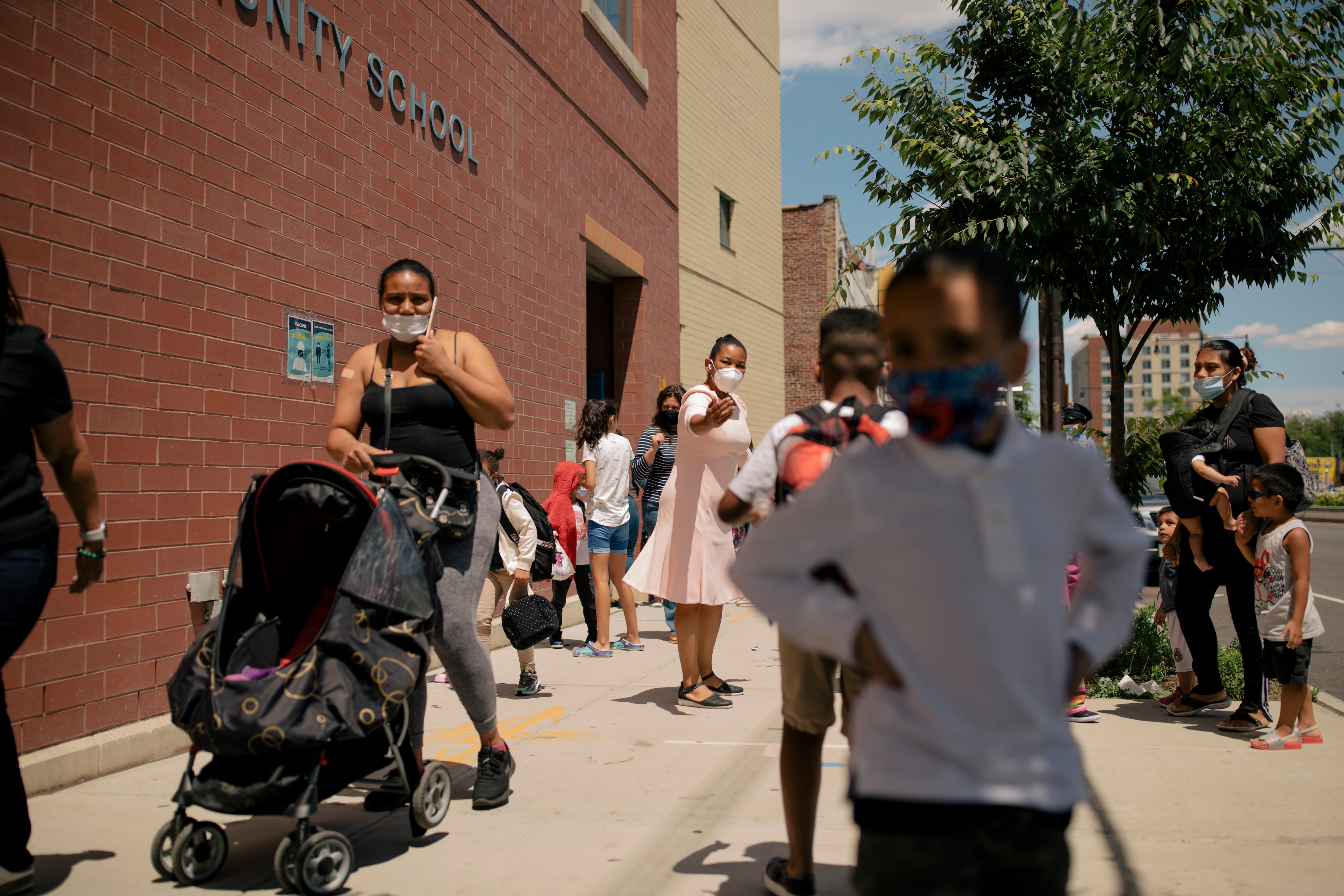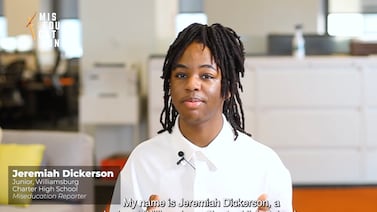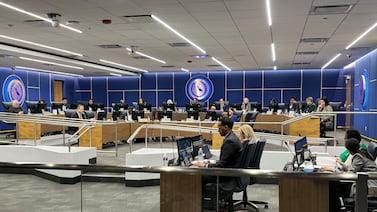This story was originally published on Feb. 8 by THE CITY.
If you’re looking to get involved in decisions in your school district, now’s a good time: Positions on the city public schools’ Community Education Councils are up for grabs.
Parents, local residents and business owners, and even high school seniors are eligible to join.
Community Education Councils, or CECs, can weigh in on nearly every facet of a student’s education: academics, budgets, transportation, safety, accessibility, diversity and inclusion, special education needs, and more.
Each of the 32 school districts in New York City has its own CEC and community superintendent, representing pre-K through 8th-grade students for that district. (High schools are represented by the separate Citywide Education Councils, which have specialized councils on special education, District 75 schools, and English Language Learners.)
We are currently more than halfway through the current councils’ term, which started in June 2021 and will wrap up by June this year. Applications for the next cohort are open until Feb. 23 to fill vacant positions before the start of the next term in July. (The education department extended the previous deadline, Feb. 13, by 10 days.)
Here’s our guide on how to apply, what’s involved in serving and what you need to know before throwing your hat in the ring. But first, the basics:
What do Community Education Councils do?
CECs are currently staffed by 11 volunteers who, per the Department of Education (DOE), evaluate educational materials and their impact on the district’s students; hold public town halls every month with the district’s superintendent; approve school district zoning lines; and provide comment, discussion, and recommendations for the district’s education policy.
But that barely scratches the surface of what CECs actually end up doing. Antonia Ferraro Martinelli, who has served on Brooklyn’s CEC15 for six years, says the council works on tackling anything that faces students in their day, be it lead in the school water fountains — an issue her council addressed in 2017 — or struggling with hybrid learning during the pandemic.
“It has to be a day that is healthy, safe and emotionally and academically stimulating,” Martinelli said. “It’s everything you need to foster a happy, healthy environment for a child.”
What actual power do CECs have to change education policy?
CECs are advisory bodies with up-or-down voting powers on only one issue: changes to school district zoning. However, joining a CEC can be a good way to influence those with decision-making powers or to mobilize public opinion, CEC veterans told THE CITY.
Collaborating with and establishing a good working relationship with the superintendent and the DOE at large — a key part of making councils successful — is another avenue to effect change, Martinelli said. Her council weighed in on decisions and strategies to reform District 15’s middle school admissions process to more accurately reflect the district’s racial and economic diversity, as parent groups formed to zero in on the district’s high-stakes and competitive admissions process.
Find out who your district’s superintendent is here.
“You have the power of your voice and the power of the press,” she said. “If CECs feel strongly about an issue, they can bring attention to it.”
Being on the CEC also means tapping into the community’s concerns on the ground level — kind of like community organizing, said Naomi Peña, who has served on Manhattan’s CEC1 for eight years. A CEC member becomes the point person for their community, directing them to resources or solutions if their child has any problems in school.
“What we really do have leverage on is being accessible to the community so you’re able to connect with families,” Peña said. “Oftentimes, if there is an issue happening with a child, you will be one of the people that the family will connect with.”
Councils also advocate for whatever their school district needs, which might shift from time to time.
For instance, during the pandemic, Peña’s council organized food drives and packed boxed meals to distribute at schools to families facing food insecurity. Peña’s council is now working on a drive for children of asylum-seekers and migrants, scheduled for next month.
Why should I join?
Martinelli recommends joining a CEC if “you want a greater voice in how the district serves its students — and you can’t just be thinking about your child, you have to think about the best interests of all children in that district.”
Peña echoed that sentiment — join if “you genuinely, really want to learn about this school education system, if you really want to make a difference in your community,” she said,
“For me, being on CEC has been fulfilling because I view it as a state of service,” Peña said.
Am I eligible to serve on a CEC?
There are three types of positions on each 11-member council. You can be:
- A parent with a child enrolled in the district
- A local resident or business owner appointed by the borough president
- A high-school senior
You don’t need any special experience, but there are some prerequisites for each type of member, and each role has a different application process (more on that later). Here’s what you need to know:
Parents and guardians
You can run for one of the nine positions reserved for parents, legal guardians or people serving as parents to a child enrolled in a non-charter public school, pre-K through the 8th grade,in the CEC’s district.
Of those nine positions, one is reserved for a parent of a child in an Individualized Education Program (IEP) and one is reserved for a parent of a child enrolled in Dual Language, Transitional Bilingual Program, or English Language Learning program.
Local residents and business owners
You can also apply to one of two positions appointed by the borough president for your district. For this one, you’ll have to be a local resident, or own or operate a business in the district you’re applying in. The position also asks for extensive “trade, business or education” knowledge, the DOE’s application says. Though these positions are appointed by an elected official, you don’t have to run and be elected yourself — just apply.
High school seniors
There is one nonvoting student position on every CEC. You can run for that spot if you’re a high school senior in the district you’re applying to and a member of student body government or hold a leadership position in a student organization, like a club. You’ll also need your parent’s consent to apply.
Who can’t apply?
Current DOE employees, people holding public office, and members of the Panel for Education Policy are ineligible.
All right, I’m ready to apply to a CEC. Where should I start?
With a form, of course.
- If you’re applying as a parent, here’s the form to fill out. Make sure to have information at hand pertaining to your district, borough, employment, volunteering experience and investments by you or your spouse. Those will be checked to screen for possible conflicts of interest between you and DOE-funded groups or projects. You’ll have to fill out every section (or type in N/A for the ones that are not applicable to you).
This form will ask you for your school’s DBN, a unique identifier for each school that stands for district, borough and school number. For the borough, you’ll have to use M for Manhattan, X for Bronx, K for Brooklyn, Q for Queens, and R for Staten Island. Find your school here.
You’ll also need to create an NYC Schools account (NYCSA), if you don’t already have one, with the details of all your children enrolled in DOE schools. This is key, said Peña — a lot of candidates couldn’t proceed with their application because their NYCSA wasn’t set up,. Setting this up and entering your information in the DOE portal automatically transfers some information over to your application.
Once you’re done, attach your form to an email and submit your application to the Family and Community Empowerment (FACE) department at ccecinfo@schools.nyc.gov.
Alternatively, you can mail your application to 52 Chambers St., Room 405, New York, NY 10007.
After the DOE vets your application, districts will hold forums — held in-person before the pandemic, and virtual since — where candidates can talk to parents in the district, hear their concerns and answer questions.
Following the forum, parents vote for their favorite candidates through their NYCSAs. (Parents, even if you’re interested in just voting, not running — it’s a good idea to set up your NYCSA, Pena said.) Decisions will be made by May before the start of the new term in July.
- If you’re applying for one of the borough president’s appointee positions, here’s the form you’ll fill out. This application, too, will ask for information about your employment, experience and investments made by you and/or your spouse.
Once you’re done, submit your application to the Family and Community Empowerment (FACE) department at CouncilApplications@schools.nyc.gov.
- If you’re applying as a high school senior, here’s the form you’ll need. The application will ask you about your experience with student clubs or student government, so have that ready.
Once you’re done, submit your application to the Family and Community Empowerment (FACE) department at ccecinfo@schools.nyc.gov.
What’s the time commitment like?
Two monthly meetings, which at minimum might go for a couple hours, are a given, Peña said. Liaising with the PTA, school leadership, as well as the superintendent and chancellor also take up a significant amount of time for CECs.
You’ll also have to participate in two DOE-led training sessions every term to get up to speed on your roles and responsibilities, determine your district’s capital needs and submit a plan to the schools chancellor, and hold town halls to let the public air their concerns.
If you’re wondering what current and previous council members have to say — you can ask! Find a list of current members for each borough and school district here, along with contact information for each district’s council.






